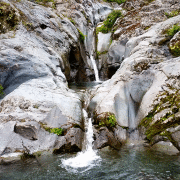Remote Connections – Tracey Benson
Despite Australia’s position as an industrialised nation, there are still significant limitations to online access in regional and remote locations. This scenario presents as a challenge as well as an opportunity for residents. Arguably, one of the most negatively impacted demographics are people living on remote Indigenous communities. There is much talk of ‘closing the gap’ between Indigenous and non-Indigenous Australians, which has resulted in a range of policy measures titled ‘Closing the Gap’.These initiatives have implications on a range of issues aside from online access – most significantly access to health, education services, housing and reliable power sources. In remote regions of Australia, there is also the added issue of vulnerability to climate change, which is extreme in Central Australia.
This project explores how strategies and technologies could be used in remote Australia to leapfrog the digital divide, empower communities and help build capacity. There are a number of steps in the life cycle design of the project that allow for the exploration of technologies and building capacity via skill sharing and cultural engagement.
In brief, the steps are:
• scoping study and environment scan
• the delivery of a series of skill sharing workshops on location at Alice Springs and Papunya
• the development of collaborative works in each location utilising digital technology and online tools
• building networks across communities to share outputs and to enhance communications between locations
• the presentation of the work in various sites and forums
The scoping exercise is focused on developing a best practice approach to engaging with remote Indigenous communities to collaboratively develop effective information communications technology (ICT) literacy skills and improved access to communications technology. It is also a documentation of my evolving understanding of the many challenges people face in remote areas and the significant impact of the digital divide specifically in smaller remote Indigenous communities.
The other linked concern having a direct impact to online access in remote localities is reliable sources of power. On this topic there has been a number of excellent energy and sustainability initiatives in remote Indigenous communities. I focus specifically on a number of communities in the Central Australian region, mainly Alice Springs, Yuendumu, Papunya and more broadly Anangu Pitjantjatjara Yankunytjatjara (APY).
My decision to research online access for remote Indigenous communities came about after I read an article discussing the high uptake of mobile phones in remote communities, particularly ‘smart’ phones with 3G Internet access. This was shortly after attending ‘Web Directions South 2010’ in Sydney where I was switched on to flexible device delivery with a web standards approach (which encompasses accessible and usable design). The developments in HTML and CSS have added increased flexibility and functionality to web design, making websites more elegant and streamlined. I also have an interest in researching semantic web and geolocation technologies and their application to genealogy and Indigenous kinship systems.
Over the years I have run many workshops in regional areas, with a focus on ‘identity’ as a means to explore media in creative ways. In ‘Remote Connections’, I will use this methodology to guide the development of collaborative works about identity and place, which will evolve from the workshops.








